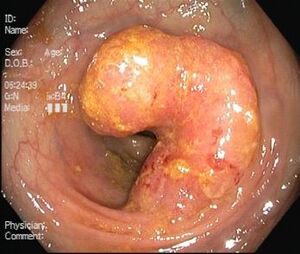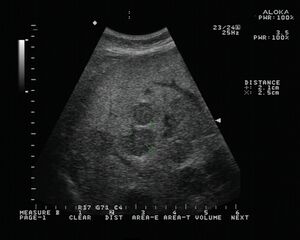Colorectal carcinoma/diagnosis
Anamnestic data[edit | edit source]
Although it might seem that in the age of modern technologies such as CT, MRI and PET CT, taking anamnesis is something obsolete, there is a whole set of symptoms that can lead a general practitioner to the right diagnosis. Symptoms are often based on the location of the colon tumor:
- visible fresh blood in the stool – it occurs mainly in aborally localized tumors (dif. dg.: hemorrhoids, IBD);
- anemization – a relatively common phenomenon, caused by small-scale chronic bleeding from an exulcerated tumor, typical mainly for tumors of the cecum and right half of the colonies, where the intestine has a larger lumen and therefore the tumor has enough time to grow before causing passage disorders;
- changes in frequency of emptying – it can be both constipation and diarrhea, again it is more typical for the left half of the colon (descendens, sigmoidum, rectum, which have a narrower lumen than the previous parts of the colon), for example, the patient tells the doctor that he used to go to the toilet every day and last months it is barely twice a week;
- tenesmus – in rectal carcinoma;
- weight loss – although quite a non-specific symptom, but common in many oncological diseases (not only GIT);
- dyspeptic disorders, general weakness, cachectization, …
- bowel perforation or ileus can unfortunately also be a condition that leads to malignancy, it is an advanced case, it is a very negative prognostic sign.
Methods of examination[edit | edit source]
- Physical examination
Symptoms of general anemia such as conjunctival and skin pallor, cachectization [2]. Examination per rectum itself can reveal a tumor in the rectum or blood in the stool[2], so it should not be neglected by general practitioners or surgeons in case of suspected GIT pathology. The importance of per rectum examination as a screening examination has not been documented yet, but in the case of a symptomatic individual it is a basic examination which should always be performed.[2]
- Colonoscopy
The benefits of this examination are almost invaluable, it is a first choice examination. In addition to diagnostics (visualization and biopsy collection), in some special cases it also enables curative intervention consisting in the suffering of precancerous lesions or even a tumor (T1). With the help of colonoscopy, an endosonographic probe can also be used to detect the depth of infiltration in the intestinal wall or other organs and to determine staging of (rectal cancer in particular). In addition, colonoscopy can be used to apply ink to the tumor site, making it easier for surgeons to find it during surgery.
- Double-contrast irigography
This is an X-ray examination of the abdomen with double contrast (barium suspension and air), and is performed when colonoscopy is not possible due to lumen obstruction or poor anatomical conditions. The examination must be completed with rectoscopy, due to possible tumors of the rectum. The main disadvantage is the fact that it is not possible to take biopsy samples or remove any polyps.
- Laboratory
In addition to signs of anemia (hypochromic, microcytic) from chronic bleeding,[2] tumor markers are obvious. In the case of colorectal cancer, these are mainly serum concentrations of CEA a Ca 19–9[2]. It is very important to realize that their benefit is not in the diagnosis of the disease, because they are non-specific. For example, elevated Ca 19-9 occurs not only in carcinoma of pancreas or bile ducts, but even in benign biliary obstruction. The benefit is in monitoring the effects of therapy (decreasing = effective chemotherapy, increasing = relapse of the disease) and then also in the prognostic benefit. High CEA at the time of diagnosis is a negative prognostic factor.
- CT
CT scans are important in detecting nodal and distant metastases, especially in liver, lungs, bones and CNS. Thanks to it, therapeutic strategies (curative resection versus palliation, use of neoadjuvance, adjuvant) are definitively determined. We perform CT of the abdomen and, in the case of rectal cancer, preoperative CT of the small pelvis, to evaluate the extent of the tumor and possible metastatic spread. According to the results, a decision is made on possible neoadjuvant radiotherapy in more extensive rectal cancers.
- MRI
Magnetic resonance imaging predominates in rectal cancer. Here it is essential to find out the degree of infiltration of small pelvic organs (bladder, ureter, vagina, but also the sacrum), do the staging and decide on the type of resection.
- Ultrasonography
Classical abdominal sonography is important in the detection of liver metastases , especially preoperatively and in the evaluation of retroperitoneal nodes.
- Endosonography
Endoscopic sonography is especially important for rectal cancers. Thanks to this technique, it is possible to determine the depth of invasion of the tumor, i.e. to which layer of the intestinal wall it reaches, or whether it affects the nearby lymph nodes or surrounding organs. It also serves to determine the staging of the disease and to plan the subsequent surgical procedure.
- Chest X-ray
It serves to exclude metastatic lung disease, it is performed in the forward projection and also as a preoperative examination.


